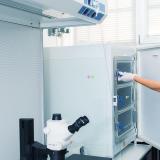There are 2 Commonwealth Acts providing a regulatory framework to prohibit certain unacceptable practices including human cloning, and to regulate uses of excess human embryos created through assisted reproductive technology.
Commonwealth Legislation
The Commonwealth Prohibition of Human Cloning for Reproduction Act 2002 and Research Involving Human Embryos Act 2002 were developed to address community concerns, including ethical concerns, about scientific developments in relation to human reproduction and the use of human embryos in research activities.
The legislation prohibits human cloning for reproductive purposes and a range of other practices relating to reproductive technology. It also regulates research activities that involve the use of human embryos created by assisted reproductive technology (ART) or by other means. There are strong penalties for noncompliance with the legislation.
- Prohibition of Human Cloning for Reproduction Act 2002
- Research Involving Human Embryos Act 2002
- Research Involving Human Embryos Regulations 2017
In addition, the following Customs Regulations relate to the import or export of stem cells derived from human embryo clones.
- Customs (Prohibited Import) Regulations 1956 (section 5L)
- Customs (Prohibited Export) Regulations 1958 (section 8A)
More information can be found on Import and Export of Cell Lines from Human Embryo Clones.
State and Territory Legislation
On 5 April 2002, the Council of Australian Governments (COAG) agreed that the Australian Government and state and territory governments would introduce nationally consistent legislation to ban human cloning and other unacceptable practices and to regulate research involving excess ART embryos. The agreement was renewed on 13 April 2007.
The following links provide state and territory legislation about research involving human embryos and prohibition of cloning. In addition, states and territories may have legislation regulating the clinical practice of assisted reproductive technologies (for example, fertility treatment legislation).
Australian Capital Territory
New South Wales
- Human Cloning for Reproduction and Other Prohibited Practices Act 2003 No 20
- Research Involving Human Embryos (New South Wales) Act 2003 No 21
Northern Territory
- Legislation is being drafted in the Northern Territory.
Queensland
South Australia
Tasmania
- Human Cloning for Reproduction and Other Prohibited Practices Act 2003 (No. 51 of 2003)
- Human Embryonic Research Regulation Act 2003 (No. 52 of 2003)
Victoria
Western Australia
Review of Legislation
The Research Involving Human Embryos Act 2002 and the Prohibition of Human Cloning Act 2002 were passed by Parliament in December 2002. The legislation has been reviewed since 2002.
The Lockhart Review (2005)
In 2005 the Legislative Review Committee, reviewed the Prohibition of Human Cloning Act 2002 and the Research Involving Human Embryos Act 2002. The review was a statutory requirement of the Acts.
The Committee’s Report from this review is:
- Legislation review: Prohibition of Human Cloning Act 2002 and the Research Involving Human Embryos Act 2002 (December 2005)
The Legislation Review Committee website is maintained as a historical record of the main documentation for the independent reviews and can be accessed via the National Library of Australia.
Amendment Act 2006
The legislation was amended in 2006 as a result of the Prohibition of Human Cloning for Reproduction and the Regulation of Human Embryo Research Amendment Act 2006. The amendments came into effect in June 2007. The Prohibition of Human Cloning Act 2002 was renamed the Prohibition of Human Cloning for Reproduction Act 2002.
Following the Amendment Act 2006, and consideration of related recommendations from the Lockhart Review, NHMRC made changes to the following guidelines and related administrative processes:
- The Objective criteria on embryos that are unsuitable for implantation (the Objective Criteria) and accompanying contextual information were issued as guidelines by the CEO of NHMRC on 6 December 2007
- NHMRC's Ethical Guidelines on the use of Assisted Reproductive Technology in Clinical Practice and Research 2017 (updated 2023)
- Licence application forms
- Monitoring arrangements.
The Heerey Review (2010)
The Amendment Act 2006 included a requirement for the Heerey Review. Information about the review and its recommendations is provided in the Report of the Independent Review of the Prohibition of Human Cloning for Reproduction Act 2002 and Research Involving Human Embryos Act 2002 (June 2011).
Maeve’s Law amendments for mitochondrial donation (2022)
In October 2022, the Mitochondrial Donation Law Reform (Maeve’s Law) Act 2022 came into effect and amended the Research Involving Human Embryos Act 2002 and Prohibition of Human Cloning for Reproduction Act 2002 to allow mitochondrial donation (an assisted reproductive technology technique that could help prevent certain rare mitochondrial diseases) to be used in research and training activities and for human reproductive purposes. NHMRC's Embryo Research Licensing Committee (ERLC) is the responsible authority for the new licensing framework.
Human embryos from processes other than fertilisation
The Research Involving Human Embryos Act 2002 requires that research involving human embryos, including excess embryos from assisted reproductive technology treatments and the creation and/or use of embryos arising by processes other than fertilisation, can only be conducted under a licence issued by the Embryo Research Licensing Committee (ERLC).
The Research Involving Human Embryos Act 2002 defines a human embryo as a discrete entity that has arisen from either:
a) the first mitotic division when fertilisation of a human oocyte by a human sperm is complete; or
b) any other process that initiates organised development of a biological entity with a human nuclear genome or altered human nuclear genome that has the potential to develop up to, or beyond, the stage at which the primitive streak appears;
and has not yet reached 8 weeks of development since the first mitotic division.
The use or creation of entities that meet the definition of a human embryo (potentially including some types of embryoids, blastoids or embryo-like structures) is illegal in Australia unless it is conducted under a licence issued by ERLC.
In 2022, ERLC issued a licence for the creation and use of artificially generated embryos that closely resemble human blastocysts (‘iBlastoids’). More detail on the background and process of the iBlastoid embryo research licence is outlined in the NHMRC Statement on iBlastoids.
As advancements in human embryo research continue to develop rapidly, ERLC considered how the legislation would be applied to various embryo models being developed. ERLC has developed a Decision Flowchart that outlines the decision process in determining how the legislation may apply to any embryo model research. Any decision taken by ERLC, once it receives a valid licence application for this research, must be based on the requirements outlined under Australian law.
Researchers are strongly encouraged to contact the NHMRC embryo regulation team for advice about whether any proposed research involving embryo-like structures (for example, embryoids, blastoids, gastruloids) is regulated by the Australian legislation. Contact the NHMRC embryo regulation team at embryo.research@nhmrc.gov.au.
Payments to egg and sperm donors
Section 21 of the Prohibition of Human Cloning for Reproduction Act 2002 states that:
(1) A person commits an offence if the person intentionally gives or offers valuable consideration to another person for the supply of a human egg, human sperm or human embryo.
Maximum penalty: Imprisonment for 15 years
(2) A person commits an offence if the person intentionally receives, or offers to receive, valuable consideration from another person for the supply of a human egg, human sperm or human embryo.
Maximum penalty: Imprisonment for 15 years
(3) In this section:
Reasonable expenses:
a) in relation to the supply of a human egg or human sperm- includes, but is not limited to, expenses relating to the collection, storage or transport of the egg or sperm; and
b) in relation to the supply of a human embryo:
i) does not include any expenses incurred by a person before the time when the embryo became an excess ART embryo;
ii) and includes but is not limited to, expenses relating to the storage or transport of the embryo.
Valuable consideration, in relation to the supply of human egg, human sperm or human embryo by a person, includes any inducement, discount or priority in the provision of a service to the person, but does not include the payment of reasonable expenses incurred by the person in connection with the supply.
In addition, the Ethical guidelines on the use of assisted reproductive technology in clinical practice and research 2007 (updated 2023) (the ART guidelines) refer to the reimbursement of gamete donors. In Part B of the ART guidelines, section 5.4 states that:
The current situation in Australia is that gamete donation must be altruistic, and that commercial trading in human gametes or the use of direct or indirect inducements is prohibited by legislation...
In reference to research, section 13.21.2 of Part B of the ART guidelines states that:
There should be no payments or other inducements for the donation of gametes… The reimbursement for reasonable out-of-pocket expenses associated with the procedures is acceptable. In research to which these Ethical Guidelines apply, reimbursement does not cover compensation, including compensation for time.
What amounts to reasonable expenses incurred in donating will vary between individuals, depending on their circumstances. Payment of a predetermined amount to all donors, without any consideration of individual circumstances, may constitute valuable consideration if the amount exceeds the reasonable expenses incurred by the individual during the donation process. Individuals or clinics must not use gametes that have been obtained by providing valuable consideration to the donor. Persons considering donating their eggs or sperm must not receive valuable consideration for their gametes.
If you suspect someone is not complying with their responsibilities under the Research Involving Human Embryos Act 2002 or the Prohibition of Human Cloning for Reproduction Act 2002, please report your allegation of non-compliance to NHMRC. Individuals and clinics may be at risk of breaching the Prohibition of Human Cloning for Reproduction Act 2002 if they provide, or receive, valuable consideration for human gametes (eggs or sperm).


